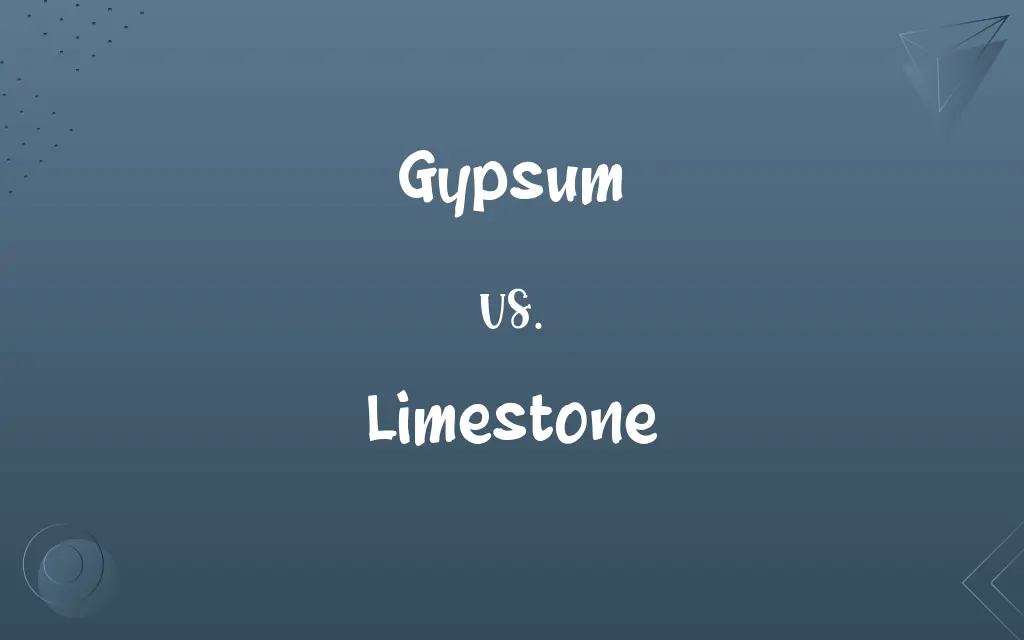Gypsum vs. Limestone: Know the Difference

By Shumaila Saeed || Updated on December 25, 2023
Gypsum is a soft sulfate mineral widely used in construction and agriculture, while limestone is a sedimentary rock composed mainly of calcium carbonate, used in building and manufacturing.

Key Differences
Gypsum is a mineral composed of calcium sulfate dihydrate, known for its softness and ease of use in drywall and plaster. Limestone, on the other hand, is a sedimentary rock, primarily made of calcium carbonate, and is used extensively in construction, cement production, and as a soil conditioner.
Shumaila Saeed
Nov 26, 2023
The use of gypsum in agriculture improves soil structure and provides vital sulfur and calcium nutrients to plants. In contrast, limestone is often used to neutralize acidic soils and in water treatment processes to adjust pH levels.
Shumaila Saeed
Nov 26, 2023
Gypsum is identifiable by its softness, being so soft that it can be scratched with a fingernail. Limestone, while still relatively soft as a rock, is harder than gypsum and is commonly used for building materials and architectural purposes.
Shumaila Saeed
Nov 26, 2023
In the realm of construction, gypsum is mainly used in the form of plaster and drywall, offering fire resistance and sound insulation. Limestone, however, is used both as a primary material in the form of blocks and as a key ingredient in cement and asphalt.
Shumaila Saeed
Nov 26, 2023
From a geological perspective, gypsum forms primarily in evaporite environments, often found in layered sedimentary deposits. Limestone typically forms in marine environments, where the accumulation of shells, corals, and other calcium-rich materials occurs over time.
Shumaila Saeed
Nov 26, 2023
ADVERTISEMENT
Comparison Chart
Hardness
Soft, can be scratched with a fingernail
Relatively harder than gypsum
Shumaila Saeed
Nov 26, 2023
Primary Use
Construction (drywall, plaster), agriculture
Construction, cement production, soil pH adjustment
Shumaila Saeed
Nov 26, 2023
Formation Environment
Evaporite environments
Marine environments, from accumulated biological material
Shumaila Saeed
Nov 26, 2023
Soil Application
Improves structure, provides sulfur and calcium
Neutralizes acidity, used in water treatment
Shumaila Saeed
Nov 26, 2023
ADVERTISEMENT
Gypsum and Limestone Definitions
Gypsum
A key ingredient in plaster of Paris and other building compounds.
The sculpture was made using plaster of Paris, derived from gypsum.
Shumaila Saeed
Nov 20, 2023
Limestone
A rock used to neutralize acidic soils in agricultural applications.
To improve soil pH, they added crushed limestone to their fields.
Shumaila Saeed
Nov 20, 2023
Gypsum
A soft sulfate mineral used in construction and agriculture.
Gypsum boards are commonly used for making drywalls.
Shumaila Saeed
Nov 20, 2023
Limestone
Commonly formed from the accumulation of shell, coral, and algal debris.
The limestone was rich in fossilized shells and coral fragments.
Shumaila Saeed
Nov 20, 2023
Gypsum
A mineral known for its fire-resistant properties in building materials.
Gypsum plaster is favored for its fire-resistant qualities.
Shumaila Saeed
Nov 20, 2023
ADVERTISEMENT
Limestone
A sedimentary rock primarily composed of calcium carbonate.
Limestone cliffs are a common sight along the coastline.
Shumaila Saeed
Nov 20, 2023
Gypsum
A source of calcium and sulfur in agricultural soil amendments.
Farmers use gypsum to enrich their soil with essential nutrients.
Shumaila Saeed
Nov 20, 2023
Limestone
Widely used in construction, both as a building material and in cement.
The historic building was constructed using limestone blocks.
Shumaila Saeed
Nov 20, 2023
Gypsum
A mineral formed in sedimentary layers, often in evaporite deposits.
The gypsum deposit was found alongside layers of salt and other minerals.
Shumaila Saeed
Nov 20, 2023
Limestone
A key material in the manufacturing of glass and steel.
Limestone is used in the glass-making process as a source of calcium.
Shumaila Saeed
Nov 20, 2023
Gypsum
A widespread colorless, white, or yellowish mineral, CaSO4·2H2O, used in the manufacture of plaster of Paris, various plaster products, and fertilizers.
Shumaila Saeed
Oct 19, 2023
Limestone
A common sedimentary rock consisting mostly of calcium carbonate, CaCO3, used as a building stone and in the manufacture of lime, carbon dioxide, and cement.
Shumaila Saeed
Oct 19, 2023
Gypsum
A mineral consisting of hydrated calcium sulphate. When calcinated, it forms plaster of Paris.
Shumaila Saeed
Oct 19, 2023
Limestone
An abundant rock of marine and fresh-water sediments; primarily composed of calcite (CaCO3); it occurs in a variety of forms, both crystalline and amorphous.
Shumaila Saeed
Oct 19, 2023
Gypsum
A mineral consisting of the hydrous sulphate of lime (calcium). When calcined, it forms plaster of Paris. Selenite is a transparent, crystalline variety; alabaster, a fine, white, massive variety.
Shumaila Saeed
Oct 19, 2023
Gypsum
A common white or colorless mineral (hydrated calcium sulphate) used to make cements and plasters (especially plaster of Paris)
Shumaila Saeed
Oct 19, 2023
Limestone
A rock consisting chiefly of calcium carbonate or carbonate of lime. It sometimes contains also magnesium carbonate, and is then called magnesian or dolomitic limestone. Crystalline limestone is called marble.
Shumaila Saeed
Oct 19, 2023
Limestone
A sedimentary rock consisting mainly of calcium that was deposited by the remains of marine animals
Shumaila Saeed
Oct 19, 2023
Repeatedly Asked Queries
Is gypsum soft or hard?
Gypsum is quite soft, easily scratched with a fingernail.
Shumaila Saeed
Nov 26, 2023
What’s the main component of limestone?
Calcium carbonate is its primary component.
Shumaila Saeed
Nov 26, 2023
What is gypsum primarily made of?
It's composed of calcium sulfate dihydrate.
Shumaila Saeed
Nov 26, 2023
What is limestone used for in building?
As a building material and in cement production.
Shumaila Saeed
Nov 26, 2023
Does gypsum have applications in agriculture?
Yes, as a soil amendment for better structure and nutrition.
Shumaila Saeed
Nov 26, 2023
What is a common use of gypsum in construction?
It's used for making drywall and plaster.
Shumaila Saeed
Nov 26, 2023
Can gypsum improve soil?
Yes, it's used to improve soil structure and provide nutrients.
Shumaila Saeed
Nov 26, 2023
How does limestone form?
From the accumulation of biological materials in marine environments.
Shumaila Saeed
Nov 26, 2023
Where does gypsum typically form?
In evaporite environments, as sedimentary deposits.
Shumaila Saeed
Nov 26, 2023
Is gypsum used in the manufacturing of plaster of Paris?
Yes, it's a key ingredient in plaster of Paris.
Shumaila Saeed
Nov 26, 2023
Are gypsum and limestone renewable resources?
They are abundant but not renewable, as their formation takes a long geological time.
Shumaila Saeed
Nov 26, 2023
Can limestone be used in water treatment?
Yes, it's used to adjust pH levels in water.
Shumaila Saeed
Nov 26, 2023
What are the geological conditions for limestone formation?
It forms in marine environments, often from shell and coral debris.
Shumaila Saeed
Nov 26, 2023
Does limestone play a role in the steel industry?
Yes, it's used in steel manufacturing.
Shumaila Saeed
Nov 26, 2023
Is limestone a versatile material in construction?
Yes, it's versatile, used in blocks, cement, and architectural elements.
Shumaila Saeed
Nov 26, 2023
Can gypsum be used for sound insulation?
Yes, in its drywall form, it provides sound insulation.
Shumaila Saeed
Nov 26, 2023
Are gypsum and limestone environmentally friendly materials?
Generally, they are considered environmentally friendly building materials.
Shumaila Saeed
Nov 26, 2023
Share this page
Link for your blog / website
HTML
Link to share via messenger
About Author
Written by
Shumaila SaeedShumaila Saeed, an expert content creator with 6 years of experience, specializes in distilling complex topics into easily digestible comparisons, shining a light on the nuances that both inform and educate readers with clarity and accuracy.






































































